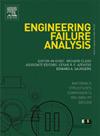Hydrogen-induced failure mechanism of X80 pipeline steel welded joints based on macro-and micro-scale experimental analysis: Embrittlement enhancement effect caused by high hydrogen trap density
IF 5.7
2区 工程技术
Q1 ENGINEERING, MECHANICAL
引用次数: 0
Abstract
The hydrogen embrittlement (HE) susceptibility of high-grade steel welded joints, represented typically by X80 steel, is significantly higher than that of the base metal (BM) while the mechanism remains unclear. To address this, a multi-scale experimental and theoretical analysis was conducted. This reasearch systematically investigated the differences in hydrogen-induced failure behavior and mechanisms between X80 steel welded metal (WM) and BM after gaseous hydrogen charging through slow strain rate tensile (SSRT) test, fatigue crack growth rate (FCGR) test, fracture morphology observation, microstructural characterization, and electrochemical hydrogen permeation experiments. The results indicate that under a 50 % N2-H2 blending condition, the reduction rate of the fracture contraction area of the WM was 6.6 times greater than that of the BM, demonstrating higher HE susceptibility. However, the FCGR of the WM was slightly lower than that of the BM, with a difference of approximately 4.45 %. Hydrogen permeation tests revealed that the hydrogen diffusion coefficient in the BM was 1.71 times higher than that in the WM. Fractography showed that hydrogen-induced failure in the BM was primarily characterized by microvoid nucleation and growth dominated by the Hydrogen-Enhanced Localized Plasticity (HELP) mechanism, while these features were less pronounced in the WM. Combined phase analysis indicated that the hydrogen trap density in the BM was approximately 81.3 % lower than in the WM. In the WM region, high dislocation density, fine grains, and high-density hydrogen traps (M/A interfaces, inclusions, etc.) lead to local hydrogen enrichment, which triggers the Hydrogen-Enhanced Decohesion (HEDE) mechanism and dislocation pinning effects earlier, presenting typical localized brittle fracture characteristics. This research clarifies the differences in HE mechanisms between the BM and the WM, identifying the local hydrogen accumulation caused by high trap density in the WM as the key reason for its high HE susceptibility. It demonstrates that local hydrogen enrichment is more detrimental than rapid, uniform diffusion. The results provide a theoretical basis for the design and safety assessment of hydrogen-resistant welded joints.
基于宏微观尺度实验分析的X80管线钢焊接接头氢致失效机理:高氢阱密度引起的脆化强化效应
以X80钢为代表的高档钢焊接接头的氢脆(HE)敏感性明显高于母材(BM),但机制尚不清楚。为了解决这个问题,进行了多尺度的实验和理论分析。本研究通过慢应变速率拉伸(SSRT)试验、疲劳裂纹扩展速率(FCGR)试验、断口形貌观察、显微组织表征和电化学氢渗透实验,系统研究了X80钢焊接金属(WM)与BM在充氢后氢致失效行为及机理的差异。结果表明,在50% N2-H2混合条件下,WM的断裂收缩面积收缩率是BM的6.6倍,表现出更高的HE敏感性。然而,WM的FCGR略低于BM,差异约为4.45%。氢气渗透试验表明,氢气在BM中的扩散系数是WM中的1.71倍。断口形貌表明,微孔在基体中的断裂主要表现为微孔形核和以氢增强局部塑性(HELP)机制为主的生长,而这些特征在基体中不太明显。联合相分析表明,BM中的氢阱密度比WM中的低约81.3%。在WM区,高位错密度、细晶粒和高密度的氢圈闭(M/A界面、夹杂物等)导致了局部氢富集,更早触发了氢增强脱粘(HEDE)机制和位错钉住效应,呈现出典型的局部脆性断裂特征。本研究阐明了BM和WM之间HE机制的差异,确定了WM中高阱密度引起的局部氢积累是其高HE敏感性的关键原因。这表明局部氢富集比快速均匀扩散更有害。研究结果为耐氢焊接接头的设计和安全性评价提供了理论依据。
本文章由计算机程序翻译,如有差异,请以英文原文为准。
求助全文
约1分钟内获得全文
求助全文
来源期刊

Engineering Failure Analysis
工程技术-材料科学:表征与测试
CiteScore
7.70
自引率
20.00%
发文量
956
审稿时长
47 days
期刊介绍:
Engineering Failure Analysis publishes research papers describing the analysis of engineering failures and related studies.
Papers relating to the structure, properties and behaviour of engineering materials are encouraged, particularly those which also involve the detailed application of materials parameters to problems in engineering structures, components and design. In addition to the area of materials engineering, the interacting fields of mechanical, manufacturing, aeronautical, civil, chemical, corrosion and design engineering are considered relevant. Activity should be directed at analysing engineering failures and carrying out research to help reduce the incidences of failures and to extend the operating horizons of engineering materials.
Emphasis is placed on the mechanical properties of materials and their behaviour when influenced by structure, process and environment. Metallic, polymeric, ceramic and natural materials are all included and the application of these materials to real engineering situations should be emphasised. The use of a case-study based approach is also encouraged.
Engineering Failure Analysis provides essential reference material and critical feedback into the design process thereby contributing to the prevention of engineering failures in the future. All submissions will be subject to peer review from leading experts in the field.
 求助内容:
求助内容: 应助结果提醒方式:
应助结果提醒方式:


